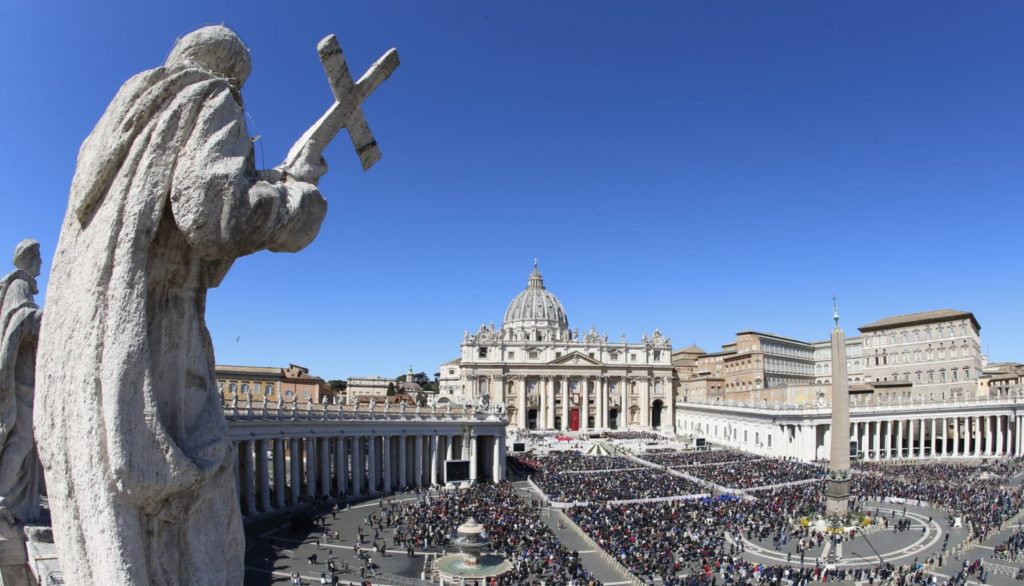The present hierarchy of the Church is the result of many historical councils and deliberations. Over time it had to define a series of ecclesiastical figures or titles that would support the Pope and the bishops in their task of governing and caring for the people of Christ. As a curiosity, the word "hierarchy" derives from two Greek words: "hierós" (sacred) and "archeía" (command).
The foundation of this hierarchy is found in Jesus Christ himself, its founder. He himself confers upon the Church the three offices of teaching, sanctifying and governing - the so-called tria munera- The apostolic succession, that is to say, the continuity throughout the centuries of the development of these functions by the one who holds the competent authority.
Jesus himself would design the model from which the Church would begin its mission. The community composed of Him, His apostles and several disciples, would give rise to the appearance of the bishops, whose head would be the Pope, forming all of them a stable college or group.
The hierarchy is based, on the one hand, on the faculty of the clergy - ordained at different levels, as we shall see - to administer the sacraments: certain rites, such as the celebration of the Eucharist, will be exclusive to the presbyters, who, together with other members, form part of the clergy.
The hierarchy is also based on the power to intervene at the level of jurisdiction: for example, determining which priest will be pastor of a given parish.
The clergy - composed of clerics - is organized at different levels in an ascending hierarchy, based on the three degrees of the sacrament of Holy Orders - Episcopate, Presbyterate and Diaconate - ranging from deacon, through presbyter, bishop, archbishop, primate, patriarch - in more particular cases - and cardinal, until reaching the supreme office of pope.
What distinguishes a bishop from a cardinal? And from an archbishop?
At the first level of this hierarchy we have cardinals, bishops and archbishops.
The cardinals are the Pope's most immediate advisors and collaborators, the vast majority of whom are bishops. They must assist the Holy Father in administering the Church. They may also participate in the conclave or election of the new pope. The distinguishing color of the cardinals is purple red, and the term by which they are addressed is eminence.
Bishops, on the other hand, obtain their office through episcopal ordination. Their tasks are to guide the dioceses, that is, the territorial and administrative units that make up the Church, as well as to ordain priests and deacons, and to administer the sacrament of Confirmation. Bishops may administer all the sacraments, including ordination. Their distinguishing color is purple, and they may be called monsignor or excellency.
Finally, it would be appropriate to refer to the archbishop. He is the bishop of an archdiocese, or rather of the diocese at the head of an ecclesiastical province composed of several dioceses. If the archbishop is also the head of the ecclesiastical province, he is called metropolitan. On the other hand, the qualification of archbishop can also be only honorary.
How is a presbyter different from a deacon?
At a second hierarchical level we find the presbyters, also called priests, who, if they are linked to a particular parish, are parish priests.
The parish, by the way, is also an administrative unit of the Church. Several parishes form a vicariate, and thus a pastor may also hold the office of vicar, coordinating several parishes in the area. Priests may administer all the sacraments, with the exception of Holy Orders.
Deacons would form a third level in the ecclesiastical hierarchy. Their task is to assist priests and bishops in ceremonies. They can only administer the sacrament of baptism and assist at marriage with particular delegation. They preach the word of God and serve in parish communities.
In some cases -more so in the Eastern Churches- the deacons embrace the diaconate on a permanent basis; in others provisionally and with a view to their subsequent priestly ordination.
Other ecclesiastical titles: apostolic nuncio, vicar general.
In addition to the above, there are other ecclesiastical titles or positions held by those who already hold a position in the ecclesiastical hierarchy.
We refer on the one hand to the case of the apostolic nuncio, who is an ambassador of the Holy See to the States; and on the other hand to the vicar general, who represents the bishop in the management of relations between parishes and vicariates, the various circumscriptions into which the diocese is territorially divided.
Does the existence of hierarchy imply inequalities among the different members of the Church?
The hierarchy of the Church does not imply inequality of the faithful, since all, clerics or not, are equally baptized. Thus, the equality of all is prior to the diversity of personal conditions in the Church as a consequence of the sacrament of Orders and the different charisms.
The hierarchy exists within and at the service of the communion of the faithful, not above the Church itself, nor, evidently, outside of it.
In other words, it is not a question of "exercise of power", but of "exercise of functions" in the service of others, on the part of any of the clergy in their various orders. For to hold a hierarchical office is nothing more than to serve all Catholics in this concrete way, no matter what authority that office implies.












